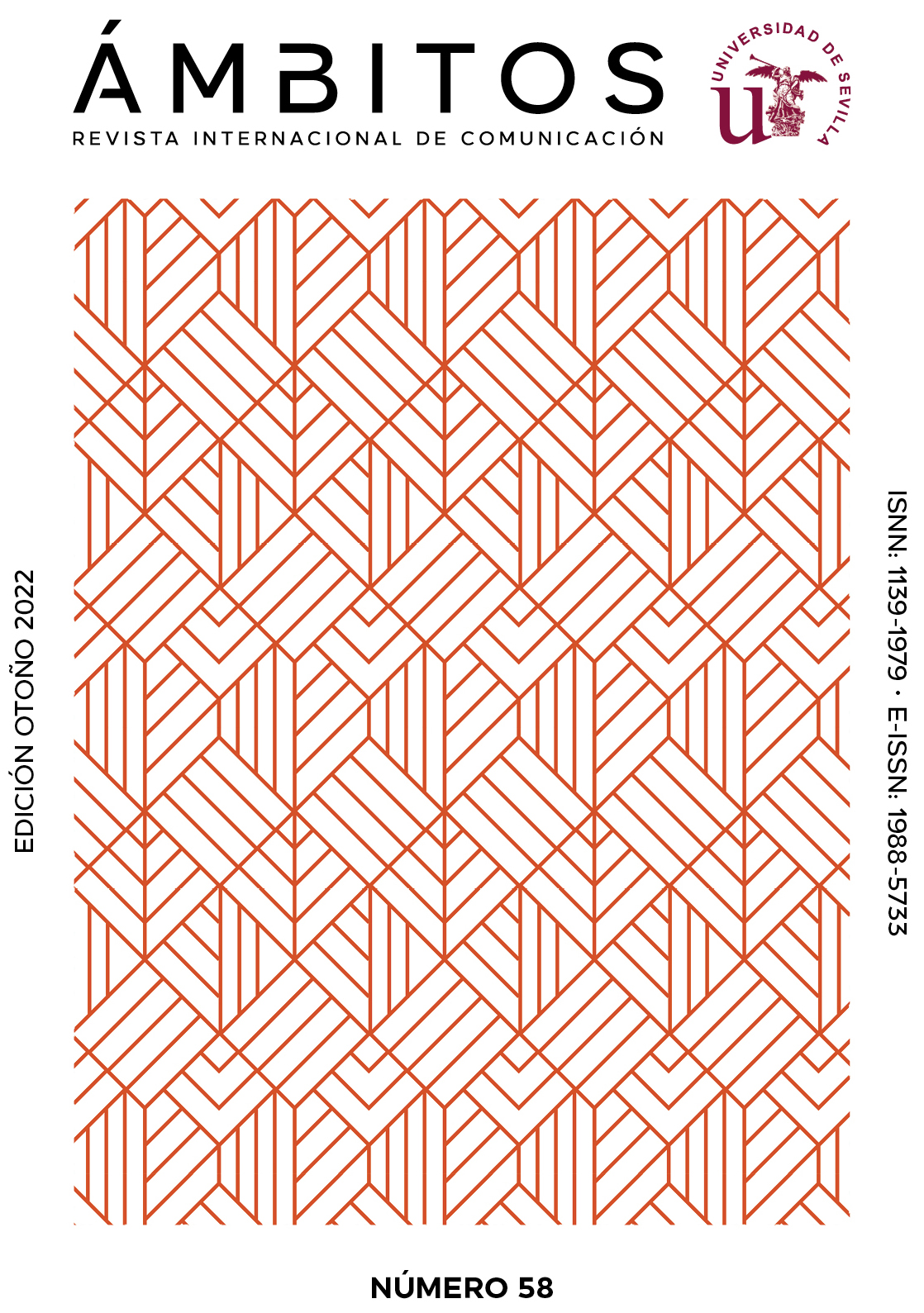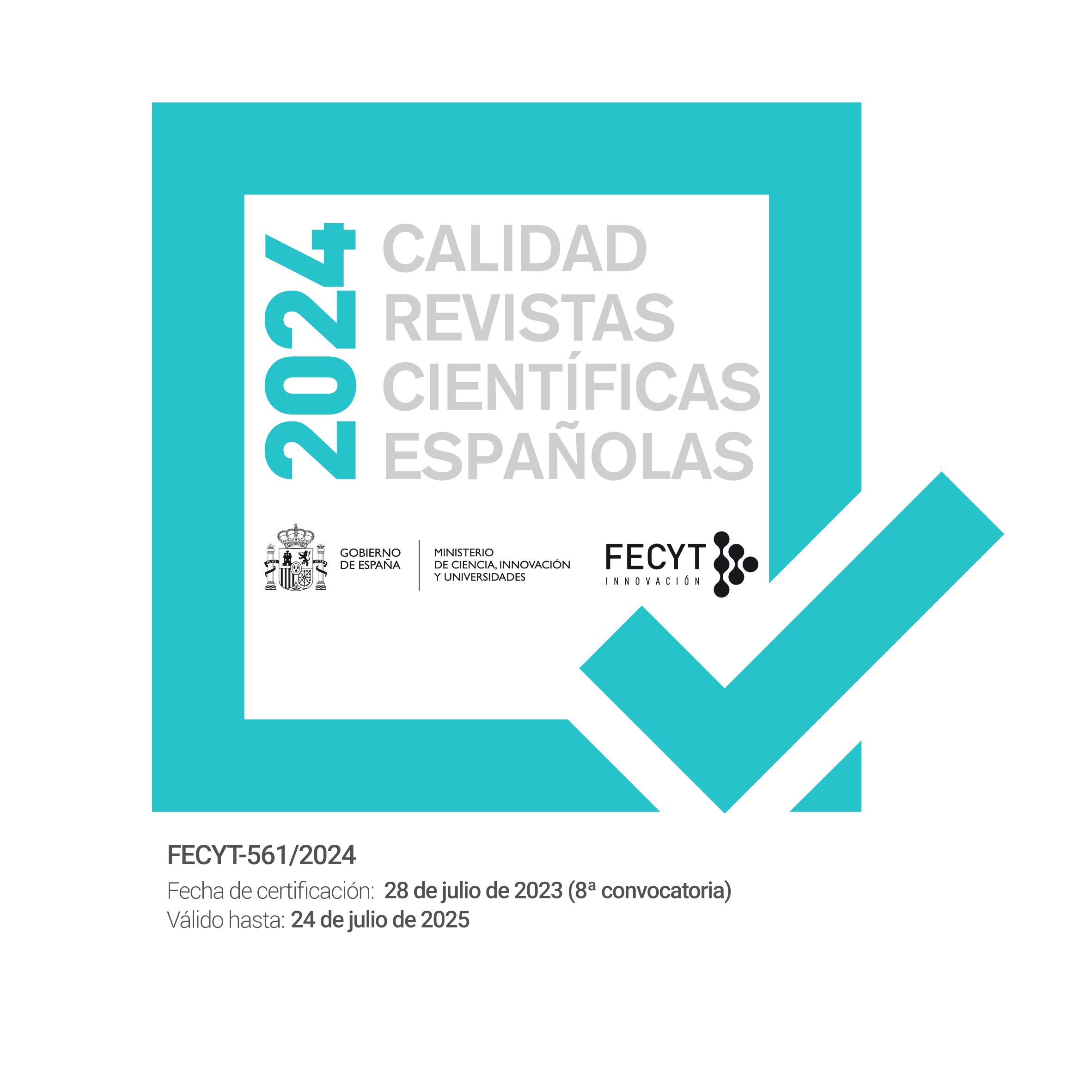Sensaciones y recuerdos: de qué están hechas las imitaciones políticas de Polònia de TV3
DOI:
https://doi.org/10.12795/Ambitos.2022.i58.07Palabras clave:
imitación, Cataluña, infoentretenimiento, comunicación política, sátira políticaResumen
Este artículo describe las principales características del proceso creativo de la imitación satírica de políticos y políticas. Los datos presentados se basan en 29 entrevistas en profundidad con miembros del equipo creativo del programa de televisión, Polònia, que desde 2006 se transmite semanalmente por la cadena pública catalana, TV3. Los artistas describen su trabajo de creación de personajes como una experiencia sensorial que es mediada por recuerdos de su memoria afectiva. Cuando se aproximan al político que deben imitar, actrices y actores buscan capturar las sensaciones físicas que esa observación ocasiona en sus cuerpos. Luego, conectan esas sensaciones con experiencias afectivas que se manifiestan en recuerdos familiares, estereotipos sociales, personajes de cultura popular, entre otros referentes. Un personaje de imitación política no es una copia del original, sino el ensamblaje de las sensaciones y recuerdos que estos políticos les inspiran a estos artistas. Esta forma de caracterizar el trabajo creativo de los imitadores resulta una novedad para la investigación en la comunicación política. Los estudios sobre humor político realizados en ese campo se han interesado principalmente en los efectos cognitivos que pueden causar en las audiencias, así como en analizar su contenido. El presente estudio, en cambio, da luces sobre las primeras etapas de su proceso creativo, lo hace dejando que sus realizadores lo narren en sus propias palabras y releva las dimensiones afectivas de la comunicación política.
Descargas
Citas
Ahmed, S. (2004). The cultural politics of emotions. Duke University Press.
Ahmed, S. (2010). Happy Objects. En M. Gregg y G. Seigworth (Eds.), The Affect Theory Reader (pp. 29-51). Duke University Press.
Altheide, D. L. (1987). Media Logic and Social Interaction. Symbolic Interaction, 10(1), 129-138.
https://doi.org/10.1525/si.1987.10.1.129
Altheide, D. L. (2004). Media logic and political communication. Political Communication, 21(3), 293-296.
https://doi.org/10.1080/10584600490481307
Altheide, D. L. (2016). Media Logic. En G. Mazzoleni (Ed.), The International Encyclopedia of Political Communication (Vol. 2, pp. 1-6). Wiley.
https://doi.org/10.1002/9781118541555.wbiepc088
Altheide, D. L. y Snow, R. P. (1979). Media Logic. SAGE Publications.
Altheide, D. L. y Snow, R. P. (1992). Media logic and culture: Reply to Oakes. International Journal of Politics, Culture and Society, 5(3), 465-472.
https://doi.org/10.1007/BF01423902
Baek, Y. M. y Wojcieszak, M. E. (2009). Don’t expect too much! learning from late-night comedy and knowledge item difficulty. Communication Research, 36(6), 783-809.
https://doi.org/10.1177/0093650209346805
Bal, A. S., Pitt, L., Berthon, P. y DesAutels, P. (2009). Caricatures, cartoons, spoofs and satires: political brands as butts. Journal of Public Affairs, 9(4), 229-237.
https://doi.org/10.1002/pa.334
Barnhurst, K. G. (2011). The new «media affect» and the crisis of representation for political communication. International Journal of Press/Politics, 16(4), 573-593.
https://doi.org/10.1177/1940161211415666
Baumgartner, J. C. (2008). Editorial Cartoons 2.0: The Effects of Digital Political Satire on Presidential Candidate Evaluations. Presidential Studies Quarterly, 38(4), 735-758.
https://doi.org/10.1111/j.1741-5705.2008.02675.x
Baumgartner, J. C. (2021). Is It Funny if No One is Watching? Public Response to Late-Night Political Satire. Comedy Studies, 12(1), 15-28.
https://doi.org/10.1080/2040610X.2020.1850101
Baumgartner, J. C. y Lockerbie, B. (2018). Maybe it Is More Than a Joke: Satire, Mobilization, and Political Participation. Social Science Quarterly, 99(3), 1060-1074.
https://doi.org/10.1111/ssqu.12501
Baym, G. (2005). The Daily Show: Discursive integration and the reinvention of political journalism. Political Communication, 22(3), 259-276.
https://doi.org/10.1080/10584600591006492
Baym, G. (2014). Stewart, O’Reilly, and The Rumble 2012: Alternative Political Debate in the Age of Hybridity. Popular Communication, 12(2), 75-88.
https://doi.org/10.1080/15405702.2014.893583
Baym, G. y Jones, J. P. (2012). News Parody in Global Perspective: Politics, Power, and Resistance. Popular Communication, 10(1-2), 2-13.
https://doi.org/10.1080/15405702.2012.638566
Berrocal-Gonzalo, S., Quevedo-Redondo, R. y García-Beaudoux, V. (2022). Política pop online: nuevas estrategias y liderazgos para nuevos públicos. Index Comunicación, 12(1), 13-19.
https://doi.org/10.33732/ixc/12/01Politi
Berrocal-Gonzalo, S., Redondo García, M., Martín Jiménez, V. y Campos Domínguez, E. (2014). La presencia del infoentretenimiento en los canales generalistas de la TDT española. Revista Latina de Comunicacion Social, 69(1), 85-103.
https://doi.org/10.4185/RLCS-2014-1002
Boland, T. (2012). Critical comedy: Satire, absurdity and Ireland’s economic crash. Irish Political Studies, 27(3), 440-456.
https://doi.org/10.1080/07907184.2012.693915
Boukes, M. (2019). Agenda-Setting With Satire: How Political Satire Increased TTIP’s Saliency on the Public, Media, and Political Agenda. Political Communication, 36(3), 426-451.
https://doi.org/10.1080/10584609.2018.1498816
Boukes, M., Boomgaarden, H. G., Moorman, M. y De Vreese, C. H. (2015). At Odds: Laughing and Thinking? The Appreciation, Processing, and Persuasiveness of Political Satire. Journal of Communication, 65(5), 721-744.
https://doi.org/10.1111/jcom.12173
Brants, K. (1998). Who’s Afraid of Infotainment? European Journal of Communication, 13(3), 315-335.
https://doi.org/10.1177/0267323198013003002
Brewer, P. R., Young, D. G. y Morreale, M. (2013). The impact of real news about «fake news»: Intertextual processes and political satire. International Journal of Public Opinion Research, 25(3), 323-343.
https://doi.org/10.1093/ijpor/edt015
Browning, C. S. (2018). “Je suis en terrasse”: Political Violence, Civilizational Politics, and the Everyday Courage to Be. Political Psychology, 39(2), 243-261.
https://doi.org/10.1111/pops.12432
Bruno, G. (2014). Surface: matters of aesthetics, materiality, and media. University of Chicago Press. https://press.uchicago.edu/ucp/books/book/chicago/S/bo17089730.html
Consell de l’Audiovisual de Catalunya. (2017). Informe sobre l’audiovisual a Catalunya 2016. CAC. https://www.cac.cat/sites/default/files/2018-04/Informe_sector_2016_esmenat_2.pdf
Consell de l’Audiovisual de Catalunya. (2018). Informe sobre l’audiovisual a Catalunya 2017. CAC. https://www.cac.cat/sites/default/files/2018-07/Ac.72-2018_ ANNEX Informe audiovisual 2017.pdf
Corner, J., Richardson, K. y Parry, K. (2013). Comedy, the civic subject, and generic mediation. Television and New Media, 14(1), 31-45.
https://doi.org/10.1177/1527476412453947
Degen, M. M. y Rose, G. (2012). The Sensory Experiencing of Urban Design: The Role of Walking and Perceptual Memory. Urban Studies, 49(15), 3271-3287.
https://doi.org/10.1177/0042098012440463
Delli Carpini, M. X. (2004). Mediating Democratic Engagement: The Impact of Communications on Citizens’ Involvement in Political and Civic Life. En L. L. Kaid (Ed.), Handbook of Political Communication Research (pp. 395-434). Lawrence Erlbaum Associates.
https://doi.org/10.4324/9781410610584
Delli Carpini, M. X, y Williams, B. A. (2001). Let Us Infotain You: Politics in the New Media Age. En W. L. Bennett y R. M. Entman (Eds.), Mediated Politics (pp. 160-181). Cambridge University Press.
Edmunds, L. (1987). Cleon, «Knights» and Aristophanes’ Politics. University Press of America.
Ferré-Pavia, C. y Gayà-Morlà, C. (2011). Infotainment and citizens’ political perceptions: Who’s afraid of ‘Polònia’? Catalan Journal of Communication y Cultural Studies, 3(1), 45-61.
https://doi.org/10.1386/cjcs.3.1.45_1
Ferré-Pavia, C., Sintes, M. y Gayà-Morlà, C. (2016). The perceived effects of televised political satire among viewers and the communication directors of political parties: A European case. European Journal of Cultural Studies, 19(4), 299-317.
https://doi.org/10.1177/1367549415592892
Flowers, A. A. y Young, C. L. (2010). Parodying Palin: How Tina Fey’s Visual and Verbal Impersonations Revived a Comedy Show and Impacted the 2008 Election. Journal of Visual Literacy, 29(1), 47-67.
https://doi.org/10.1080/23796529.2010.11674673
Gregg, M. y Seigworth, G. (2010). An inventory of shimmers. En M. Gregg y G. Seigworth (Eds.), The Affect Theory Reader (pp. 1-28). Duke University Press.
Hall, S. (1980). Encoding/decoding. En S. Hall, D. Hobson, y A. Lowe (Eds.), Culture, Media, Language: Working Papers in Cultural Studies, 1972-79 (pp. 128-138). Routledge Ltd; Centre for Contemporary Cultural Studies University of Birmingham.
Henry, S. G. y Fetters, M. D. (2012). Video Elicitation Interviews: A Qualitative Research Method for Investigating Physician-Patient Interactions. The Annals of Family Medicine, 10(2), 118-125.
https://doi.org/10.1370/afm.1339
Holbert, R. L., Hmielowski, J., Jain, P., Lather, J. y Morey, A. (2011). Adding Nuance to the Study of Political Humor Effects: Experimental Research on Juvenalian Satire Versus Horatian Satire. American Behavioral Scientist, 55(3), 187-211.
https://doi.org/10.1177/0002764210392156
Jones, J. P. y Baym, G. (2010). A Dialogue on Satire News and the Crisis of Truth in Postmodern Political Television. Journal of Communication Inquiry, 34(3), 278-294.
https://doi.org/10.1177/0196859910373654
Jones, M. (2017). Satire, social media and revolutionary cultural production in the Bahrain uprising: From utopian fiction to political satire. Communication and the Public, 2(2), 136-153.
https://doi.org/10.1177/2057047317706372
Jorgensen, D. (1989). Participant Observation: A Methodology for Human Studies. SAGE Publications.
Kim, Y. M. y Vishak, J. (2008). Just Laugh! You Dont Need to Remember: The Effects of Entertainment Media on Political Information Acquisition and Information Processing in Political Judgment. Journal of Communication, 58(2), 338-360.
https://doi.org/10.1111/j.1460-2466.2008.00388.x
Kvale, S. (1996). Interviews: an introduction to qualitative research interviewing. SAGE Publications.
Lee, H. y Kwak, N. (2014). The Affect Effect of Political Satire: Sarcastic Humor, Negative Emotions, and Political Participation. Mass Communication and Society, 17(3), 307-328.
https://doi.org/10.1080/15205436.2014.891133
MacDowell, D. M. (1995). Aristophanes and Athens: An Introduction to the Plays. Oxford University Press.
Martinez, A. y Atouba, Y. (2021). Political Satire TV Shows in the Trump’s Era: Examining Their Impact on Latinx Viewers’ Political Knowledge, Political Engagement, and Trust in Institutions. Southern Communication Journal, 86(5), 460-471.
https://doi.org/10.1080/1041794X.2021.1958913
May, T. (2001). Social research: issues, methods and process (3.a ed.). Open University Press.
Michaud Wild, N. (2015). Dumb vs. Fake: Representations of Bush and Palin on Saturday Night Live and Their Effects on the Journalistic Public Sphere. Journal of Broadcasting y Electronic Media, 59(3), 494-508.
https://doi.org/10.1080/08838151.2015.1055001
Penney, J. (2020). ‘It’s So Hard Not to be Funny in This Situation’: Memes and Humor in U.S. Youth Online Political Expression. Television and New Media, 21(8), 791-806.
https://doi.org/10.1177/1527476419886068
Richardson, K., Parry, K. y Corner, J. (2013). Political culture and media genre: Beyond the news. Palgrave Macmillan.
https://doi.org/10.1057/9781137291271
Ryabinska, N. (2022). Politics as a Joke: The Case of Volodymyr Zelensky’s Comedy Show in Ukraine. Problems of Post-Communism, 69(2), 179-191.
https://doi.org/10.1080/10758216.2020.1816836
Shao, L. y Liu, D. (2019). The Road to Cynicism: The Political Consequences of Online Satire Exposure in China. Political Studies, 67(2), 517-536.
https://doi.org/10.1177/0032321718791373
Solaroli, M. (2015). Iconicity: A category for social and cultural theory. Sociologica, 9(1), 1-52.
Spradley, J. P. (1979). The ethnographic interview. Harcourt Brace Jovanovich College Publishers.
Tsakona, V. (2018). Intertextuality and/in political jokes. Lingua, 203(1), 1-15.
https://doi.org/10.1016/j.lingua.2017.09.003
Tsakona, V. y Chovanec, J. (2020). Revisiting intertextuality and humour: fresh perspectives on a classic topic. The European Journal of Humour Research, 8(3), 1-15.
https://doi.org/10.7592/ejhr2020.8.3.tsakona
Van Zoonen, L. (2005). Entertaining the citizen: when politics and popular culture converge. Rowman y Littlefield.
Van Zoonen, L., Coleman, S. y Kuik, A. (2011). The Elephant Trap: Politicians Performing in Television Comedy. En K. Brants y K. Voltmer (Eds.), Political Communication in Postmodern Democracy (pp. 146-163). Palgrave Macmillan UK.
Descargas
Publicado
Cómo citar
Número
Sección
Licencia
Derechos de autor 2022 Mario Álvarez Fuentes

Esta obra está bajo una licencia internacional Creative Commons Atribución-NoComercial-CompartirIgual 4.0.
Ámbitos. Revista Internacional de Comunicación es una revista de acceso abierto, lo que significa que todo su contenido está disponible gratuitamente para el usuario o su institución. Los usuarios pueden leer, descargar, copiar, distribuir, imprimir, buscar o enlazar con el texto completo de los artículos, o utilizarlos para cualquier otro fin lícito, sin solicitar permiso previo al editor o al autor. Esta definición de acceso abierto se ajusta a la Iniciativa de Acceso Abierto de Budapest (BOAI).

A menos que se indique lo contrario, todo el contenido de la edición electrónica se distribuye bajo una " licencia internacional Creative Commons Attribution-NonCommercial-ShareAlike 4.0 ". Puede consultar la versión informativa y el texto legal de la licencia aquí. Esto debe indicarse expresamente de esta manera cuando sea necesario.
En caso de aceptación del manuscrito, los autores ceden los derechos de la obra para su publicación a Ámbitos. Revista Internacional de Comunicación bajo el contrato de licencia Reconocimiento-NoComercial-CompartirIgual 4.0 Internacional (CC BY-NC-SA 4.0). Los autores conservan los derechos de autor y terceros están autorizados a copiar, distribuir y hacer uso de la obra, siempre que cumplan con los términos y condiciones establecidos en la licencia.
- Citar la autoría y la fuente original de publicación (revista, editorial y URL de la obra).
- No los utilice con fines comerciales.
- Si remezcla, transforma o crea a partir del material, debe publicar sus contribuciones bajo la misma licencia que el original.
Se puede encontrar más información en https://creativecommons.org/licenses/by-nc-sa/4.0/deed.es



















